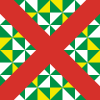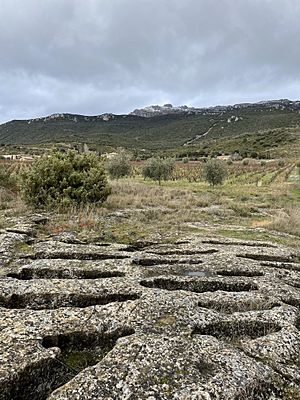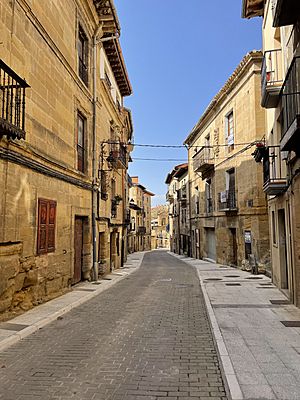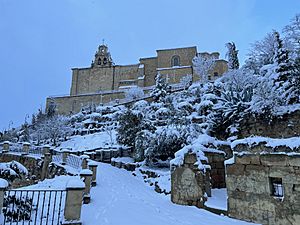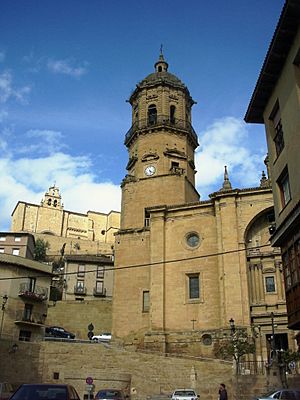Labastida facts for kids
Quick facts for kids
Labastida / Bastida
|
|||
|---|---|---|---|

Labastida seen from the east
|
|||
|
|||
| Country | Spain | ||
| Autonomous community | |||
| Province | Alava | ||
| Eskualdea / Comarca | Rioja Alavesa | ||
| Founded | 1196 | ||
| Area | |||
| • Total | 38.17 km2 (14.74 sq mi) | ||
| Population | |||
| • Total | 1,489 | ||
| • Density | 39.010/km2 (101.03/sq mi) | ||
| Time zone | UTC+1 (CET) | ||
| • Summer (DST) | UTC+2 (CEST) | ||
| Postal code |
01330
|
||
| Official language(s) | Basque, Spanish | ||
Labastida (also called Bastida in Basque) is a charming town and municipality in northern Spain. It is located in an area called the Rioja Alavesa. This region is part of the Alava province in the Basque Country. The town sits beautifully between the River Ebro and the Sierra de Toloño mountain range. It is not far from the city of Haro and the Basque capital, Vitoria-Gasteiz.
Contents
History of Labastida
People have lived in this area for a very long time. We know this because of ancient stone structures called dolmens and old burial sites from the Neolithic period. An archaeological site nearby shows that a group of people called the Berones lived here before the Romans. They moved to this region around 400 BC.
The small church of Santa Lucia dates back to the 9th century. The necropolis (a large ancient cemetery) of Remelluri is even older. It has about 300 tombs carved right into the rock. These tombs are thought to be from the 10th century. Most of the burials were Christian. However, some Muslim burials also took place here. This was when the region was part of Al-Andalus, which was ruled by the Moors.
After the Christian kingdoms took back control (this was called the Reconquista), the Muslim presence here became smaller. Labastida then became part of the Kingdom of Navarre. During this time, new settlers arrived from the Christian kingdoms of Navarre and Castile. They spoke either Basque or Spanish. A Jewish community also continued to live in the village. The area around Plaza del Olmo is still known as the Jewish Quarter today. Underneath this neighborhood, old wine cellars now use tunnels and caves. These were once used by the Jewish community for their private ceremonies.
In the Middle Ages, Labastida was a strong, fortified town. It was in an important spot near the Ebro River. It was also at a crossroads for routes between Burgos, Pamplona, and the Basque coast. Because of this, the town was often fought over. It changed hands many times between Navarre and Castile from the 10th to the 13th centuries. Finally, in the 16th century, it became a permanent part of Alava.
During this period, the town became very rich and successful. Many grand palaces were built on the Calle Mayor (Main Street). You can still see 29 stone coats of arms carved into their fronts. The beautiful church, Our Lady of the Assumption, was also built then. It was constructed in the 16th and 17th centuries and decorated in a rich Baroque style.
Manuel Quintano (1756-1818), a winemaker from Labastida, is famous for bringing the Bordeaux winemaking style to La Rioja. He learned this style after studying in France. In 1808, the famous French leader Napoleon Bonaparte even visited Labastida. He stayed at the Paternina Palace.
Geography of Labastida
The town of Labastida is located at an altitude of 529 meters (about 1,736 feet). It is perfectly placed between the River Ebro and the Sierra de Toloño mountain range.
Labastida has a temperate oceanic climate. This means it has mild temperatures and some rain. However, it also has strong influences from continental and Mediterranean climates. The area gets about 733mm of rain each year. This is not a lot for the Basque Country. It rains more in spring and autumn. Winters are cool, but it rarely snows. Summers are usually hot and dry.
Economy of Labastida
Labastida is located in the Rioja Alavesa wine region. This means that making wine is the town's main industry. People have been making wine here for over a thousand years! Old stone wine presses, called lagares, have been found in the town and nearby countryside. Some of these date back to at least the 10th century.
Today, there are still many wineries in and around Labastida. Other important industries include tourism and growing other farm products.
Facilities in Labastida
The town council provides several facilities for its residents. There is a sports center, a fronton (a court for a traditional Basque sport), and public swimming pools.
The Quintano Palace, located near the town hall, is now a cultural center. Here you can find the tourism office, a library, and rooms for games and music. It also has other community facilities for everyone to enjoy.
Labastida also has a school and a walk-in health clinic. You can find various shops, hotels, guesthouses, and a wide range of bars and restaurants in the town.
Localities in Labastida Municipality
The walled village of Salinillas de Buradón (Buradon Gatzaga in Basque) is part of the Labastida municipality. It is located about 6 kilometers (4 miles) northwest of Labastida. Salinillas de Buradón became part of Labastida in the 1970s.
Other small places within the municipality include the hamlet of Remelluri. This is now a winery. There are also the long-abandoned villages of Tabuérniga, Torrontejo, and Buradón.
Places of Interest in Labastida
- The church of Our Lady of the Assumption: This beautiful church was built in the 16th century. It has a rich Baroque style inside. It overlooks the main square, Plaza de la Paz. The Baroque sacristy was added in the 18th century. The church tower is 54 meters (177 feet) tall.
- The hermitage of Santo Cristo: This is the oldest church in town. It is located at the highest point and dates from the 12th century.
- Casa Consistorial: This grand palace is now the town hall. It was built between 1730 and 1745.
- Town walls: You can still see parts of the old walls that once protected the town.
- Palaces in the Calle Mayor: Many historic palaces line the main street, showing the town's past wealth.
- Arco del Toloño and Arco de Larrazuría: These are the two old gateways that still stand, marking entrances to the town.
- Park of San Ginés: This park is a great starting point for many walking trails. These trails lead into the Sierra de Toloño mountains. You can even find a track to the summit and the abandoned Monastery of Santa María de Toloño.
- San Andrés de Muga aqueduct: An old aqueduct that once carried water.
See also
 In Spanish: Labastida para niños
In Spanish: Labastida para niños


